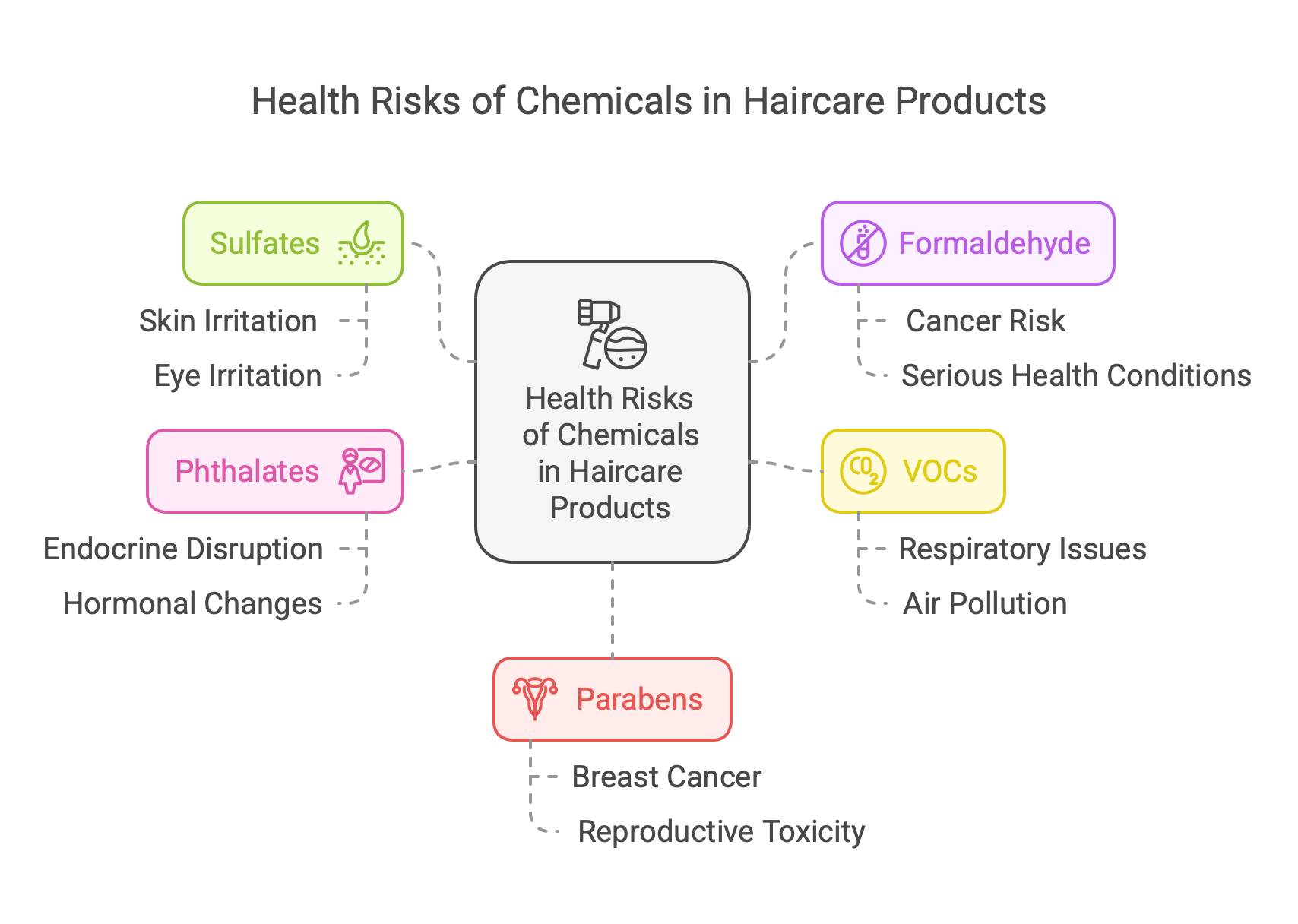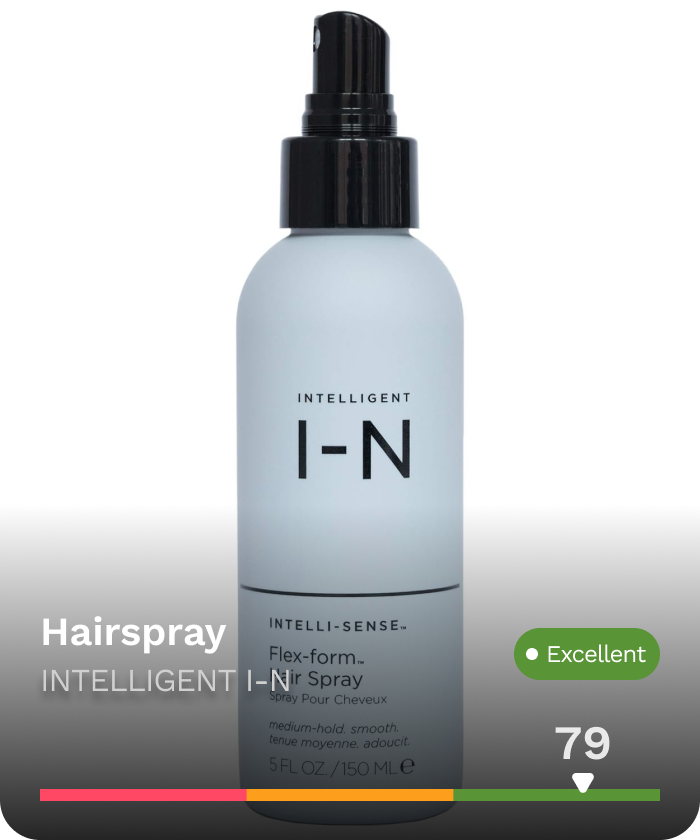TL;DR
Harmful Chemicals in Mass-Market Hair Care Products
-
Sulfates (SLS and SLES): These foaming agents in shampoos and conditioners clean hair effectively but can cause dryness, frizz, and irritation by stripping natural oils.
-
Endocrine Disruptors (Parabens and Triclosan): Found in various bath products, these chemicals can interfere with hormonal balance, potentially leading to health issues.
-
Choosing Safer Alternatives: Reading product labels and selecting “clean” hair care options free from harmful chemicals reduces exposure and supports overall skin and hair health.
Health Risks of Hair Care Chemicals
-
Common Harmful Chemicals:
- Sulfates (SLS, SLES): Cause dryness, irritation, and frizz by stripping hair’s natural oils.
- Formaldehyde and Releasers: Linked to cancer, skin irritation, and allergies.
- Phthalates and Parabens: Disrupt hormones, with links to cancer and reproductive toxicity.
- Volatile Organic Compounds (VOCs): Found in styling products; cause respiratory issues, pollute indoor air, and are linked to potential neurological and liver harm.
-
Respiratory Health Risks:
- VOCs from heat styling can linger indoors, contributing to respiratory and environmental issues.
- Reactions between VOCs and ozone may create harmful particles, though long-term effects remain under investigation.
-
Long-Term Effects:
- Chronic exposure to chemicals in hair care products (e.g., relaxers) may lead to hormone disruption, cancer risks, and conditions like dermatitis.
-
Safer Alternatives:
- Opt for natural, organic, or sulfate-free products.
- Ensure proper ventilation during styling to reduce VOC inhalation.
Specific Health Risks
- Sulfates (e.g., SLS): Found in shampoos for lathering, but they can strip natural oils, leading to dryness, frizz, and irritation.
- Formaldehyde and Releasers: Used as preservatives; linked to cancer, allergies, and respiratory issues like asthma.
- Volatile Organic Compounds (VOCs): Emitted during heat styling; harmful to respiratory health and contribute to air pollution.
- Phthalates and Parabens: Disrupt hormones, leading to developmental and reproductive issues.
- Silicones: Create shine but cause buildup, dryness, and breakage over time.
- Other Harmful Ingredients:
- Alcohols and Artificial Colors: Cause dryness and irritation.
- Propylene Glycol: Triggers skin irritation and allergic reactions.
Importance of Reading Haircare Product Labels
-
Why It Matters: Decoding haircare labels empowers consumers to avoid harmful ingredients and choose products that promote hair health.
-
Focus on the First Five Ingredients: These dominate the product’s composition. For example, water listed first means the product is water-based.
-
Ingredients to Look For:
- Humectants: Hyaluronic acid, glycerin (moisturize).
- Emollients: Shea butter, coconut oil (reduce frizz).
- Proteins: Keratin, silk amino acids (repair damage).
- Antioxidants: Vitamin E, green tea (protect from damage).
-
Ingredients to Avoid:
- Sulfates: Harsh cleansers causing dryness.
- Parabens: Preservatives linked to skin irritation.
Common Harmful Chemicals in Haircare Products
Many mass-market hair care products contain potentially harmful chemicals that can
have adverse effects on both your hair and overall health. One of the most common
harmful ingredients found in shampoos and conditioners is sulfates, specifically
sodium lauryl sulfate (SLS) and sodium laureth sulfate (SLES). These compounds
are used as foaming agents to produce lather, which helps in cleaning the hair.
However, they can also cause skin and eye irritation, dryness, and frizzy hair[7][8].
Moreover, these harsh cleansers can strip the hair of its natural oils, leading to further
dryness and inflammation[11].
Another category of harmful chemicals includes endocrine disruptors such as
parabens and triclosan. These substances are often found in various toiletry and
bath products and can affect hormonal balance in the body. Studies have shown that
individuals who avoid products containing these chemicals are less likely to have
high levels of these substances in their bodies[9].
The prevalence of these harmful ingredients in hair care products highlights the
importance of being mindful of the ingredients listed on product labels. Opting
for “clean” products, which are designed to be free from harmful chemicals and
are environmentally friendly, can reduce exposure to these potentially hazardous
substances[9][11]. By being vigilant about the ingredients in your hair care products,
you can better protect your skin health and overall well-being.
ALVA Favourites
When you make a purchase through retailer links on our site, we may earn commission through affiliate programs. All affiliate fees ALVA receives support our mission. Learn more here
Are your products safe?
Scan your products now with the ALVA app to get a personalised risk analysis.

Health Risks Associated with Haircare Chemicals
Haircare products, while promising luscious locks, often contain a variety of chem-
icals that pose significant health risks. Many mass-market shampoos, conditioners,
and styling products contain harmful substances that can lead to both immediate and
long-term health issues[1][5][23].
One of the primary concerns is the presence of sulfates, which are commonly
found in shampoos for their lathering properties. However, sulfates can cause skin
and eye irritation and contribute to frizzy hair[1][20]. Similarly, formaldehyde and
formaldehyde releasers, used as preservatives, have been linked to cancer and other
serious health conditions[2][21][24].
Volatile Organic Compounds (VOCs), such as siloxanes, are another group of chemi-
cals found in many hair care products[3][18][19]. These compounds easily evaporate
at room temperature and can be inhaled during regular use, especially when heat
styling tools are employed[22][26]. The inhalation of VOCs has been associated
with various respiratory issues, and certain populations, such as individuals with
pre-existing respiratory conditions, are more vulnerable to these effects[25][27][29].
Additionally, VOCs contribute to indoor and outdoor air pollution, further compound-
ing their health risks[3][12][16].
Phthalates, used as solvents and fixatives, and parabens, employed as preserva-
tives, are other notorious chemicals found in hair care products. Phthalates are known
to disrupt endocrine functions, while parabens have been linked to breast cancer
and reproductive toxicity[6][24]. Other harmful ingredients include artificial colors and
fragrances, which can trigger allergic reactions and hormonal disruptions[4][6][23].
In light of these risks, it’s crucial to read product labels and opt for safer alternatives
such as natural, organic, or sulfate-free products. By doing so, consumers can avoid
exposing themselves to these hazardous chemicals and maintain both their hair
health and overall well-being[6][24].
Respiratory Health
VOCs and Indoor Air Quality
Volatile Organic Compounds (VOCs) are a group of carbon-based chemicals that
easily evaporate at room temperature, making them prevalent in indoor environments
where a wide range of products are used daily[14]. Hair care products, such as oils,
gels, and sprays, often contain ingredients that emit VOCs[15]. These emissions can
significantly alter indoor air composition, especially during heat styling routines like
straightening and curling[18]. The process is further exacerbated when ventilation
systems distribute these compounds throughout the building, impacting both indoor
and outdoor air quality[15].
VOCs from haircare products accumulate in indoor environments through everyday
use and can pose serious health risks when inhaled over time[13]. This issue
is compounded by the higher concentration of VOCs found indoors compared to
outdoors—up to ten times higher—due to the limited ventilation and the continuous
use of VOC-emitting products[16].
The health impacts of these compounds are still being studied, but initial findings
suggest potential adverse effects[17]. To mitigate the impact of VOCs on indoor air
quality, it is advisable to select hair care products with lower VOC content, ensure
proper ventilation during and after product use, and minimize the use of heat styling
tools[12][19].
Impact on Respiratory Health
Many people’s bathroom cabinets are filled with products used for both hygienic
and cosmetic purposes. These personal care products contain various chemicals
that can emit volatile organic compounds (VOCs) into the air, potentially leading to
serious health problems[25]. Haircare products, in particular, have been shown to
release significant amounts of VOCs, such as siloxanes, especially when used with
heat styling tools[26]. These emissions are not confined to the indoors; they can also
impact outdoor air quality through ventilation systems[26].
Research indicates that using haircare products can change the indoor air composi-
tion quickly, and common heat styling techniques like straightening and curling can
increase VOC levels even further[29]. Inhalation of these chemicals is a concern, as
cyclic volatile methyl siloxanes (cVMS) and other VOCs can linger in the air long after
their use[27]. On average, individuals can inhale a cumulative mass of 1-17 milligrams
of potentially harmful chemicals during a single hair care session[28]. These findings
have been described as extremely alarming by researchers[28].
Studies have shown that inhaling these VOCs can harm laboratory animals’ respira-
tory tracts, livers, and neurological systems[30]. Additionally, the reactions between
VOCs and ozone in the air can produce new compounds and particles that might
penetrate deeply into the lungs, although the long-term effects of inhaling these
particles are still unknown[31]. Consequently, while the full extent of the health
impacts of inhaling these chemicals remains uncertain, it is unlikely that they are
harmless[26].
Long-term Health Effects
Prolonged exposure to harmful chemicals in hair care products can lead to a range
of long-term dermatological health consequences. Many hair care products contain
chemicals such as sulfates, parabens, phthalates, formaldehyde, and silicones,
which are used as preservatives, color enhancers, and fragrances[33][36][37]. These
substances, while providing short-term benefits like improved lather or extended
shelf life, can disrupt bodily functions and are often linked to chronic diseases and
developmental issues[33].
One significant concern is the inhalation of volatile organic compounds (VOCs) during
daily hair care routines. Studies have shown that typical hair styling activities can
release substantial amounts of VOCs into the air, leading to potential inhalation of
harmful chemicals[32][34]. This exposure is not only detrimental to indoor air quality
but also affects outdoor environments through ventilation systems[32].
Hair care products, particularly those used predominantly by Black women, such
as hair relaxers, have been associated with serious health risks, including hormone
disruption and certain cancers[35][36]. For instance, cyclic volatile methyl siloxanes,
commonly found in these products, can linger in the air and be inhaled, contributing
to cumulative chemical exposure[34]. Researchers have found these emissions to be
significantly higher than expected, raising concerns about their long-term impact on
health[32][34].
Furthermore, ingredients like formaldehyde and its releasers, used in many hair
products, are known to be carcinogenic and can lead to skin irritation, allergic
reactions, and long-term skin conditions such as dermatitis[33][37]. The chronic
exposure to these harmful chemicals underscores the need for greater awareness
and the selection of safer alternatives to mitigate potential health risks.
Specific Health Risks
Many mass-market hair care products contain potentially harmful chemicals that
pose various health risks. Understanding these risks can help consumers make
informed choices.
One of the most common harmful chemicals found in shampoos are sulfates, which
are used to create a lathering effect. Sulfates, such as sodium lauryl sulfate (SLS),
can lead to skin and eye irritation and contribute to frizzy hair[20]. These chemicals
can strip the scalp of natural oils, leading to dryness and irritation.
Formaldehyde and its releasers are another group of chemicals to be wary of.
Often used as preservatives, they can cause allergic reactions and are classified as
carcinogens, meaning they have the potential to cause cancer[21]. Formaldehyde
can also irritate the respiratory system, leading to conditions such as asthma or
exacerbating existing respiratory issues.
Volatile organic compounds (VOCs) emitted during typical hairstyling routines pose
additional risks. When heated, products containing VOCs can release harmful com-
pounds into the air, which can be inhaled, posing risks to respiratory health. This can
occur especially during the use of heat styling tools, contributing not only to indoor
air pollution but potentially affecting outdoor air quality through ventilation[22].
Phthalates, often used as plasticizers in hair care products, and parabens, used
as preservatives, have been linked to endocrine disruption. These chemicals can
interfere with hormone function, leading to developmental, reproductive, and other
systemic health issues[24].
Silicones, while they make hair appear smooth and shiny, can build up on the hair and
scalp, potentially leading to dryness and breakage over time. Alcohols and artificial
colors can also contribute to dryness and irritation[24]. Propylene glycol, used as a
humectant, can cause skin irritation and allergic reactions in some individuals[24].
By being aware of these harmful ingredients and their associated risks, consumers
can better navigate the overwhelming array of hair care products and choose those
that prioritize their health and well-being. Opting for natural, organic, or sulfate-free
alternatives can be a safer choice for maintaining healthy hair and minimizing expo-
sure to these hazardous chemicals[24].
Consumer Awareness
Reading product labels on haircare items can often feel like deciphering a foreign
language due to the plethora of ingredients and confusing terms listed. Understand-
ing these labels is crucial in making informed choices about the products we use on
our hair. According to Dr. Debra Lin, Chief Scientific Officer at Better Not Younger,
knowing how to decode these labels can help consumers avoid potentially harmful
ingredients and select products that benefit their hair health[38].
One essential tip is to focus on the first five ingredients listed on the label, as they
constitute the majority of the product’s composition. For example, if water is listed
first, it indicates that the product is primarily water-based[40]. This method simplifies
the process of identifying the main components of the product, making it easier to
understand its effects on hair.
Key ingredients to look for include humectants like hyaluronic acid and glycerin, which
attract moisture and prevent dryness; emollients such as shea butter and coconut oil,
which smooth the hair cuticle and reduce frizz; proteins like keratin and silk amino
acids, which help rebuild damaged hair; and antioxidants such as vitamin E and green
tea, which protect hair from environmental damage[41].
Conversely, consumers should be wary of ingredients that could pose health risks.
Sulfates, for instance, are harsh cleansers that can strip hair of its natural oils,
potentially leading to dryness and irritation. Parabens, used as preservatives, have
been linked to skin irritation and other health concerns[41].
By cultivating the habit of reading and understanding ingredient labels, consumers
can make more informed decisions, ensuring their haircare products support their
hair health rather than compromising it[39].
REFERENCES:
[1]: 17 Dangerous Ingredients to Avoid in Hair Care Products – Consumer Notice
[2]: The Hidden Hazards: Unveiling Toxic Chemicals in Your Hair Care Products
[3]: Hair Products Can Emit Potentially Dangerous Chemicals, Study Warns
[4]: Be Careful Of These 18 Harmful Chemicals In Your Hair Care Products
[5]: 15 Harmful Ingredients In Shampoos And Conditioners That … – SkinKraft
[6]: Decoding the Dangers: Harmful Hair Care Ingredients to Avoid
[7]: 17 Dangerous Ingredients to Avoid in Hair Care Products – Consumer Notice
[8]: 10 Harmful Ingredients to Avoid in Shampoos and Conditioners – eMediHealth
[9]: The Chemicals to Avoid in Your Shampoo and Body Wash – Healthline
[10]: 16 Toxic Shampoo Ingredients Bad for Hair – Small Batch Goodness
[11]: Looking for a New Shampoo? You May Want to Avoid These Ingredients
[12]: Hair Care Products Release Volatile Compounds, Affecting Indoor Air Quality
[13]: How Safe are Your Personal Care Products? – American Lung Association
[14]: Volatile Organic Compounds: Indoor Air Quality Explained
[15]: Hair Products Can Emit Potentially Dangerous Chemicals, Study Warns
[16]: Volatile Organic Compounds’ Impact on Indoor Air Quality
[17]: Mixing heat with hair styling products may be bad for your health
[18]: Siloxane emissions during the use of hair care products can pose health …
[19]: Is Your Hairstyling Routine Creating Harmful Indoor Emissions?
[20]: 17 Dangerous Ingredients to Avoid in Hair Care Products – Consumer Notice
[21]: The Hidden Hazards: Unveiling Toxic Chemicals in Your Hair Care Products
[22]: Hair Products Can Emit Potentially Dangerous Chemicals, Study Warns
[23]: 15 Harmful Ingredients In Shampoos And Conditioners That … – SkinKraft
[24]: Decoding the Dangers: Harmful Hair Care Ingredients to Avoid
[25]: How Safe are Your Personal Care Products? – American Lung Association
[26]: Hair Products Can Emit Potentially Dangerous Chemicals, Study Warns
[27]: Study: hair care product chemicals can linger in the air in surprising …
[28]: Study finds high levels of chemicals in hair care products
[29]: Siloxane emissions during the use of hair care products can pose health …
[30]: Morning hair routine can expose individuals to harmful chemicals, study …
[31]: How personal care products affect indoor air quality – EPFL
[32]: Hair Products Can Emit Potentially Dangerous Chemicals, Study Warns
[33]: The Hidden Hazards: Unveiling Toxic Chemicals in Your Hair Care …
[34]: Study finds high levels of chemicals in hair care products
[35]: The Health Burden of Hair Care – National Institute of Environmental …
[36]: The Science Behind Chemical Hair Care: Unveiling the Risks and …
[37]: Decoding the Dangers: Harmful Hair Care Ingredients to Avoid
[38]: How to Read Hair Product Labels Like a Pro | BNY – Better Not Younger
[39]: How to Read Hair Product Ingredients Like A Pro!
[40]: How To Read Intimidating Hair Product Labels – Essence
[41]: Decoding Hair Ingredients: What to Look For (and Avoid)
Are your products save?
Download ALVA to check if the products you use regularly are free from dangerous chemicals.

